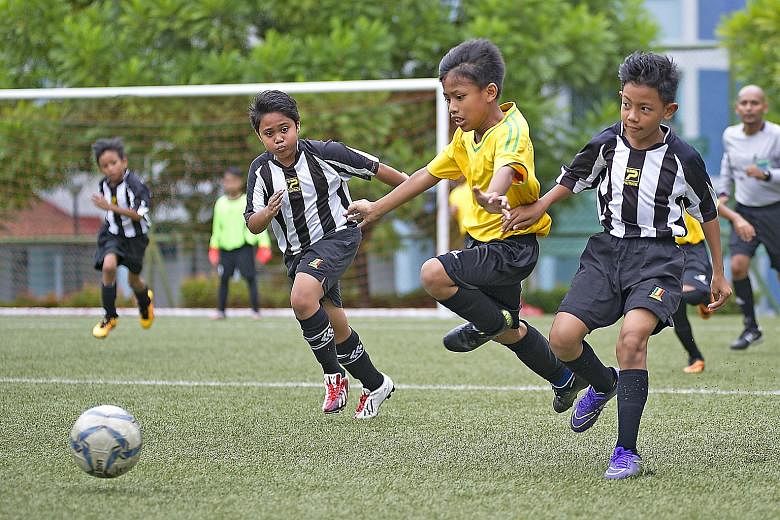When it comes to developing a new pipeline of young skilful footballers for Singapore, sometimes less could be more.
Starting this year, football tournaments for primary schools will be eight-a-side instead of nine, as both the Football Association of Singapore (FAS) and the Education Ministry believe this will give boys and girls more time on the ball and a better chance to hone their skills.
Team sizes were cut once in 2012, when they were trimmed from 11 to nine, but footballing authorities believe it is best to drop one more player, to stay in step with the best practice internationally on developing youth football.
FAS deputy president Bernard Tan told The Sunday Times: "When fewer players are playing, they are more involved in the game."
The approach to the game will also be different. Currently, youth-level football adopts what Tan describes as "beehive thinking", where the players just group together and chase the ball.
"In an eight-a-side game, players can develop their touches," he said. "Winning is not everything. We will have coaching clinics to encourage the ball to be played on the ground instead of pumping it up in the air."
-
CHANGES THROUGH THE YEARS
-
2012 Primary school matches to be nine-a-side instead of the usual 11-a-side.
2017 Kick-ins to replace throw-ins to encourage possession play. But some schools used these scenarios as set-pieces and it was later ruled that kick-ins should not be above knee-height.
2018 Schools will now play eight-a-side games to give players more space to express their skills.
He hopes the children will play a style of football based on quick passes, rapid movement, ball control and technique.
Ideally, school coaches should attain a minimum qualification of an Asian Football Confederation 'C' coaching license, he added.
Another initiative in the works is an inaugural inter-primary school futsal tournament to get younger kids started on the five-a-side variant of the sport.
The new thinking has been endorsed by all the main bodies involved - FAS, Ministry of Education (MOE), and the Singapore Primary Schools Sports Council.
Tan Chen Kee, MOE's divisional director of student development curriculum, said that all the partners agree on the need to organise developmentally appropriate competitions for students and cutting team size to eight will achieve this goal for both junior (Primary 4-5) and senior (Primary 6) divisions.
"It will better allow students to put into practice the fundamental skills and techniques learnt," she said. "We hope this will make football even more engaging for students, cultivate their joy of playing, and in the process, foster important values such as teamwork and resilience."
Geylang Methodist Primary School's teacher-coach Christopher Maik, 39, welcomes the change. "A lot of primary school fields are very small and eight-a-side is perhaps the maximum to allow for meaningful football, or else the field is too crowded," he said.
School pitches need to be 50m-70m long and 30m-50m wide for competition use but, according to Maik, most schools tend to have smaller fields.
With the plan, FAS hopes to remedy two problem areas of youth football in Singapore - a small talent pool and the recent poor results suffered by the various national age-group teams.
In 2014, an FAS survey of 100 of the 187 primary schools revealed that only 5.9 per cent of of boys and 1.6 per cent of girls play the sport.
With fewer talented players coming through, Singapore suffered a string of disappointing results at various age-group competitions.
Last August, the Under-22s were eliminated from the group stage for the second straight SEA Games. Three months later, the U-18s had three sent off in the 2-4 loss to Mongolia in an Asian Football Confederation U-19 Championship qualifier.
FAS hopes the new approach will turn things around. With three fewer starters from a squad of 15, it is also encouraging schools to send a second team to give more players a chance to compete.
Its intention is welcomed by Wesley Fernandez, whose 11-year-old son Casey plays for St Joseph's Institution Junior. "It gives more chances to more kids," said the 39-year-old. "Otherwise, they may never get the opportunity."
Roslan Saad, the teacher-coach of Shuqun Primary, also backed the move. But the 46-year-old, who has 100 students playing football as a co-curricular activity in his school, cautioned that a big gap in standards could have an adverse effect.
"There are powerhouses in every zone and it is not uncommon to see lopsided scores," he said. "Much as some schools like to be in tune with FAS' aim to develop kids, it can be demoralising to play passing football when you are losing 8-0."
More children playing - and staying in - football will provide FAS with a base to build on.
"It is no secret that the big issue is participation," said Bernard Tan.
"We need to get more and more kids to play from a younger age. If we can get them to start between the age of five and eight, we have a good chance of developing their skills to a high level and perhaps, help them embark on the elite path.
"If we depend only on the weekend academies and the current system, we'll never get the numbers."
The FAS runs its own academy, the FAS Football Academy (FFA), formerly known as the National Football Academy (NFA). It coaches elite players aged 15-18.
In addition, the FAS has oversight of the centres of excellence (COE) training U-14, U-16 and U-18 youths run by local S-League clubs.
On the NFA's name change this year to the FFA, Tan explained: "Previously, the base was narrow. It was a case of the FAS seeding the COEs and letting them develop talent. But now we want a lot of academies to spring up around the country - the more the better.
"We want schools to be recognised (as an academy). We hope that, for example, a school like Hong Kah Secondary can stand a fair chance when they face Singapore Sports School."


